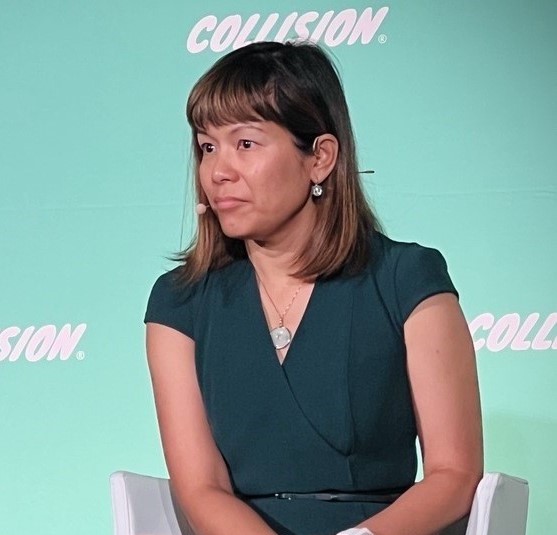Related news
Discover more stories about Mitacs — and the game-changing innovations driven by students and postdocs.
It’s hard to imagine a technological future that won’t be AI-powered. So, why are Canadian SMEs slow to adopt it?
This was a central theme at this year’s Collision Conference, the last one in Toronto, where more than 37,000 people attended from 117 countries to discuss the latest breakthroughs in AI and tech. Here are some questions you might be asking as a small business owner or social innovator, along with key insights from the AI industry.
For some AI experts, the complexities of wide-scale AI adoption go beyond performance metrics as they present grave challenges for the future of humanity.
According to Geoffrey Hinton, AI pioneer and recipient of the 2018 A.M. Turing Award (aka the Nobel Prize of Computing), it’s a double-edged sword.

“AI agents will be the same,” Hinton explained. “It’ll realize that the same subgoal works for everything: If I get more control, just take the control away from the people. Getting more control helps.”
The very existence of AI agents may sound like something out of The Matrix. But it’s already in the works and it’s making waves as we know it—just not for the same reasons. On day 2 of Collision, we heard from Matt Wood, VP of AI at Amazon Web Services, who described multi-agent systems as “increasingly collaborative systems of work and play.”
For Wood, the bigger challenge for businesses is figuring out the right time to invest in this once-in-a-lifetime opportunity.
VP of AI, Amazon Web Services

It requires collaboration, consent, and diversity of perspectives that can ensure that the future we’re building serves everyone in and outside the innovation ecosystem.
That includes small players with big ideas.
Founding Executive Director, Partnership for Inclusive Innovation

This is vital for any business that plans to use AI to remain competitive. With mounting concerns around disinformation, data privacy, and cybersecurity, many human-centered innovators are wondering how to move forward without sleeping on this trailblazing technology.
A complex question, but not without answers.
One way to combat disinformation, for instance, is to “inoculate” the public by introducing disclaimers at the end of false messages. Here’s how Hinton described it: “Pay for a lot of advertisements where you have a very convincing fake video, and then right at the end of it, it says: This was a fake video. […] It’s just like inoculation…so that people can build up resistance.”
In other words, it’s time to think outside the box.
As large language models like ChatGPT get increasingly performative, they become shinier and more marketable to the public. But is it all hype, similar to innovation theater, or can it actually create an environment conducive to human productivity?
According to a study published by Harvard Business School, MIT, and UPenn:
Yet the reality is that 73% of businesses in Canada—almost 3 in 4—have not even considered using it. Much of this stems from safety concerns, regulatory ambiguity, and the colossal challenge of navigating a field steeped in controversy, intrigue, skepticism, and admiration.
Then there’s the elephant in the room: the possibility of mass layoffs resulting from AI automation.
But it’s not all doom and gloom, according to Aidan Gomez, CEO and founder of Cohere, a Toronto-based AI startup that just locked in $450 million for a $5.5 billion valuation. “I’m a big believer in augmentation and not displacement, so I don’t foresee people losing jobs.” Gomez reassured audiences at Collision.

According to the 2024 Work Trend Index Report, users spend 60% of their time in chat and meeting apps, and only 40% in creation apps like Word and PowerPoint. It’s no surprise that 68% of people struggle with the pace and volume of work while 46% feel burned out.
For Michael Platt, neuroscientist and professor at UPenn, this data tells a clear story.
“These findings align perfectly with how our brains manage the trade-offs between routine task execution and innovation—different kinds of thinking supported by two distinct but interacting neural networks in the brain. When we’re constantly switching, we don’t work as well. AI can help liberate workers from menial work and enable innovation and creativity to flourish.”
This is further corroborated in the aforementioned study by MIT and Harvard.
“[…] Rather than blindly adopting AI outputs, highly skilled workers need to continue to validate AI and exert cognitive effort and experts’ judgement when working with AI.”
In this case, the secret to boosting productivity is empowering staff to experiment with AI and ensuring a human-centered lens throughout the process.
The answer lies in scalability and individual use case.
Understanding where and how to apply AI in the context of your unique business could unlock productivity, significantly cut costs, and help you prepare for a future where intelligence will be scalable.
“Language is everywhere,” he said about the future of LLMs. “There isn’t a function inside your company that doesn’t use language.”
And consulting firms are taking notes. Recently, Cohere struck up partnerships with McKinsey and Accenture, who plan to build custom AI solutions to improve customer engagement, workflow automation, and provide advanced capabilities for clients.
The results of these partnerships—and others like it—will soon be felt throughout the economic landscape.
The Brookfield Institute for Innovation + Entrepreneurship projected that AI could deliver $17 trillion of economic impact worldwide by 2030. For Canada, it’s estimated to contribute $210 billion to the economy. It’s clear the technology is here to stay and it’s opening new doors for collaboration.
At a time of growing disinformation, it’s critical to separate AI fact from fiction and be thoughtful about implementing changes that will impact the world.
That’s where human-centered AI expertise comes in.
AI Advisor, Mitacs

If there was ever a time to make innovation accessible for more people in more places, including small to medium-sized businesses in niche sectors, female founders, and Indigenous entrepreneurs, this is it. But to get there, we’ll need stronger academic-industry connections and a shared vision for the future.
This means joining hands with the right people who can offer both strategic insights and investment to build and follow through on this human-centered vision—a sentiment echoed by Gomez himself:
Small business innovators are no strangers to uncertainty. In fact, it’s a world they practically live in. The big fear then isn’t tech adoption; it’s the rise of oligopolies and things going awry.
***